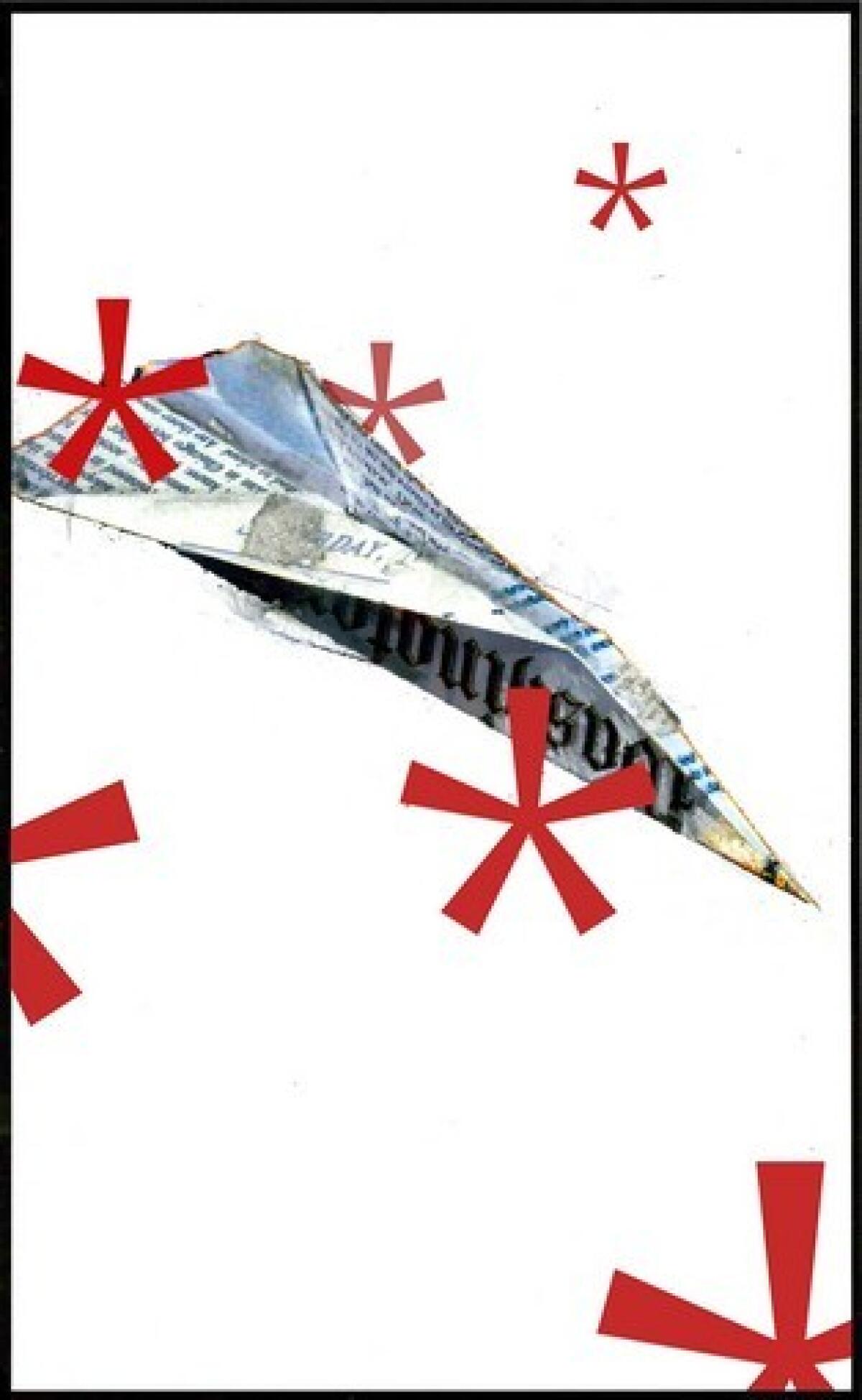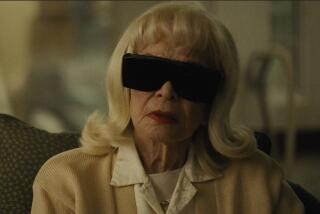‘The Room and the Chair’ by Lorraine Adams

The Room and the Chair
A Novel
Lorraine Adams
Alfred A. Knopf: 316 pp., $25.95
Lorraine Adams is a singular and important American writer. “The Room and the Chair” establishes this without question: It is remarkable for its ambitions and its achievements. It’s a war novel, a reporter’s novel and a psychological thriller. It encompasses the broadest outlines of our world. It is also Adams’ second novel, and it is gutsier and throws a wider net than the topical and gorgeously written “Harbor,” her first. Both books are about U.S. involvement in the Middle East, about psychological and political blowback, about what happens when you wage a war and then suddenly it slaps you back, blindsides you.
Adams loves the ambiguity that comes from looking at any political event from all angles. “Harbor” told the story of a terrorist cell operating in the U.S. Is the cell a true terrorist cell, we are left to wonder, or just a bunch of Middle Eastern refugees trying to make a life in a new country, guys who got caught up in some second-rate scheme that looks like terror to intelligence authorities? Here, Adams makes the enemy compelling. She understands too that in a very real sense, the enemy is us.
“The Room and the Chair” is a continuation of the work begun in “Harbor.” It’s a trippy book that begins with a plane crash and Air Force pilot Mary Goodwin hanging wounded from a tree in Washington, D.C.’s Rock Creek Park. From there, it moves through the snows of Hindu Kush to Bagram Air Base, with a detour to the 7-star Burj Al Arab hotel in Dubai. It takes place in the desert and in the mountains and in the city. But its center is the room of the title, which is the newsroom of a newspaper not so loosely based on the Washington Post, where Adams used to work. This territory is so accurately and perceptively portrayed that anyone who’s spent time in a newsroom, especially in the era of print under siege, will recognize the unsavory, nauseating mash-up of romance, hatred, rivalry, corruption and (at the same time) the almost saintly quest for truth. For newbie reporter Vera Hastings, who’s trying to make sense of Mary’s plane crash, there are uncomfortable feelings as she tries to figure out what is at play in a big story (even the reporters often cannot know).
There are all kinds of influences at work on this book: One feels the hand (but, gratefully, not the style) of Henry James, of Joan Didion, of Ward Just, of all the novelists who’ve written Washington books ( Gore Vidal too). Also in the mix are John le Carré and Norman Mailer. (Have they ever been mentioned together before?)
But there is more -- Adams moves us through phases of discovery about her characters and what they signify. Her writing about Mary, for instance, forces her to face directly the relation of soldier to kill, especially in a time of drones and long-distance, technological warfare. We learn who makes decisions in war, and who are appropriate victims. The book is about war’s human toll on soldier and civilian, on the guy who pulls the joystick as well as those who are the targets below. It’s night; Mary looks down from her plane at the place she is to bomb: “a green house in a green village.” She contemplates the pickle-shaped bomb release in front of her. “She had a five-hundred-pounder. She tossed it on a seed.”
Later, Mary ponders the detachment of this war, of modern warfare, even as she confronts the real-world impact of that bombing raid. “There was a girl,” she notes, looking at photographs left her by an injured friend. “Everything she wore had been white. . . . The bomb had taken her legs. . . . There were more of these girls in white . . . one, two, three, four. . . .”
The image of these victims in their matching white nightgowns dominates the sudden finale of the novel, raising an issue that should lie close to the heart of any novelist who writes about war and terror: the innocent enemy. Who is finally innocent and who is not? When Mary herself becomes a target of terror, we have to ask: Is she really innocent, as she sits on a chair in a dark room in the hands of her captors awaiting her fate?
Adams walks a linguistic tightrope to bring Bagram Air Base and Afghanistan to life. We see the tunnel-like huts on the base, the utter unprivate quality of military life, the whole of Bagram so susceptible to cold and snow and the panoply of horrors that make up winter in Afghanistan. “Blankets of snow whumped against the hut,” she writes. The snow is “splotching,” it’s “scat.” Mary mushes through it, it is “fluffed,” “muffled,” “packed”; it’s a “sky dump.”
Even if you are starved for fresh writing, Adams’ banquet of nouns as verbs, verbs as nouns and adverbs as adjectives can interrupt the novel’s flow. In one instance, an Iranian character thinks: “This gorp of a nurse didn’t get it.” Assuming his Farsi might include the concept of gorp, which means trail mix, it’s an odd way to describe a human being. Another character, a woman in Washington brooding about her three grown sons, thinks, “Of course they were right -- they were moleculed to be right.” It’s irritating and show-offy, and it makes you think more about the writer than the work. Mary’s back story too is weak, told in flashback and with a telegraphed speed that make it seem false and unnecessary. It’s either too big a piece of her to be scanted in this way or it shouldn’t be here at all.
But the book is so good, you just don’t care, and much of the urgent writing works. The action flies along. Along the way we have mini-portraits of Midget (Ahmadinejad) and Mean Man ( Dick Cheney); we visit the outer reaches of Afghanistan in the snow, town houses in Georgetown, the depths of Rock Creek. The black editor who passes for white; the old depressed night editor; the spook who wishes for some kind of absolution; the Iranian operative -- each has a take on the world and what he’s made of it. The novel is replete with profound offhand remarks about the human condition, some of them so arresting they can make you gasp.
The women especially glow with life. Mary is a fully realized heroine, almost Victorian in her decorum, yet lusty beneath the uniform in unexpected ways. Mabel Cannon, wife of the newspaper’s aging star reporter, is frail and vivacious, sexy and insecure, a betrayer who loves men -- many men -- and pushes forward a report that should explain how Mary’s test flight over the Potomac ended up in a fiery crash. Baby, a teenage prostitute who witnesses the crash, is especially affecting, with her ripped stuffed animal and a speech pattern that’s paticular and amusing, semi-literate but highly intelligent.
Indeed, one of the triumphs of this book is that it’s a war novel that’s mostly about women: Mary, Mabel and Baby as well as Vera, the reporter and truth seeker. Though often unwitting tools and even more often thwarted, they are the fulcrum of the book, lifting what might otherwise be a dazzling thriller into the realm of literature.
Wilentz is the author, most recently, of “I Feel Earthquakes More Often Than They Happen.” She teaches at UC Irvine.
More to Read
The biggest entertainment stories
Get our big stories about Hollywood, film, television, music, arts, culture and more right in your inbox as soon as they publish.
You may occasionally receive promotional content from the Los Angeles Times.










